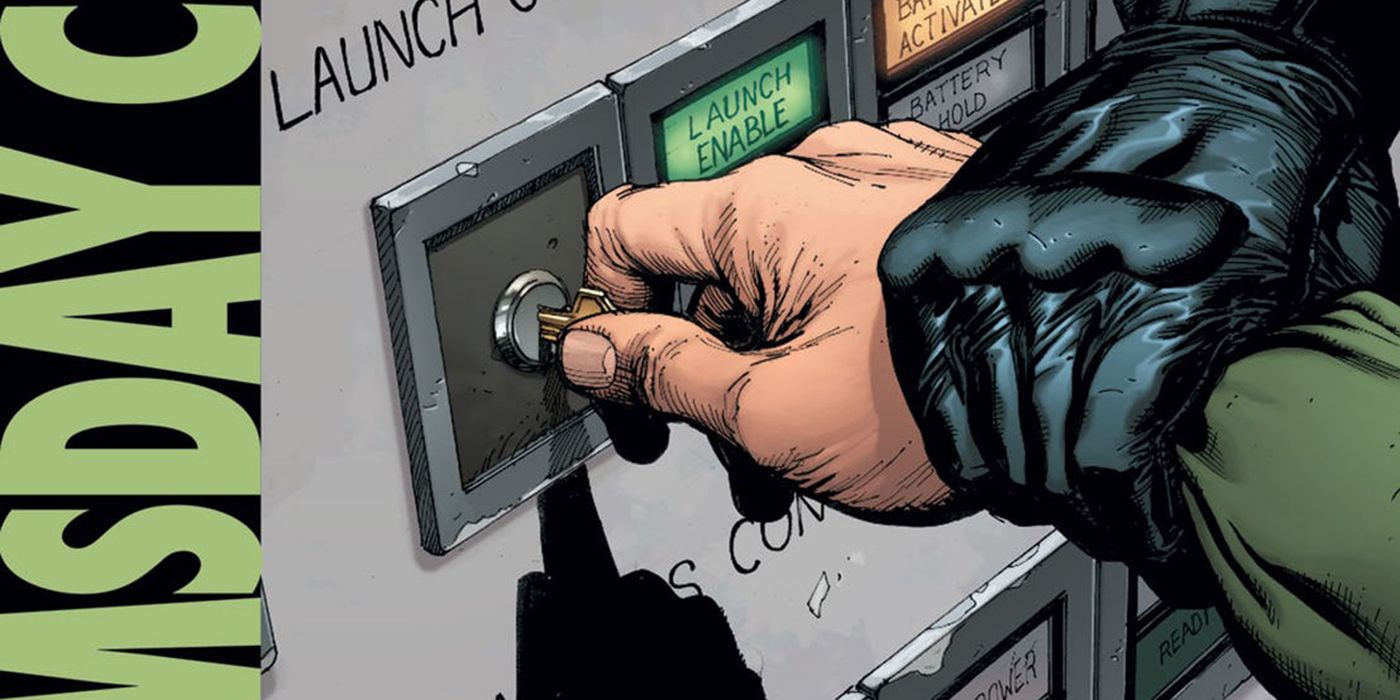
WARNING: The following post contains spoilers for Doomsday Clock #11, on sale now.
The penultimate issue of Watchmen is famous for Ozymandias' chilling revelation, "I did it thirty-five minutes ago." While there's nothing like that in Doomsday Clock #11, writer Geoff Johns and artist Gary Frank nevertheless amp up the tension with a couple of super-fights and a lot of updates on key players.
Inspired by Alan Moore and Dave Gibbons' classic 12-issue series Watchmen, Doomsday Clock #11 was written by Geoff Johns, drawn by Gary Frank, colored by Brad Anderson and lettered by Rob Leigh. Amie Brockaway-Metcalf designed the text pages.
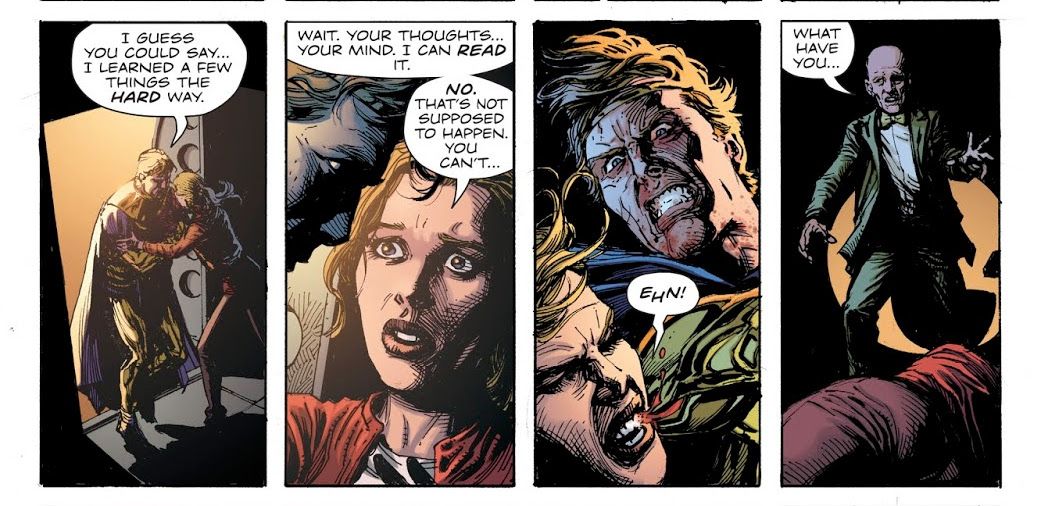
This issue checks in with a number of characters who haven't been seen since the end of Issue 7, when Doctor Manhattan entered the narrative in a big way. Brought back by Alan Scott's power battery, he interacted with Batman, the Joker, Rorschach II, the Comedian, Ozymandias, and Mime & Marionette. We know what's been going on with Batman (more on that in a minute), and we saw Ozymandias in the Oval Office at the start of Issue 8.
As for the others, Rorschach II has begun living on the street (Pages 16-18), while the Joker has been chasing the refugees from Watchmen world through Gotham (Page 1). The city is relatively vigilante-free, because Batman has been busy crashing the Batplane over Russia (Issue 8), recovering from the crash while a number of affiliated Bat-folk went to Mars. It's not been a great back half of Doomsday Clock for the Dark Knight. Anyway, by Page 27, Mime, Marionette, Comedian and Rorschach II are all speeding toward the same general area.
Nevertheless, we're confused about how Alan's battery got into Johnny Thunder's cell. On Page 27 of Issue 7, Marionette took it and left with Mime and the captive Comedian, while Rorschach II beat up Ozymandias and the Joker. Next, on Page 26, Ozymandias returned to the Owlship, where he subdued Johnny Thunder and Saturn Girl, and declared that he had a plan. He still didn't have the battery at that point (look at Page 26, Panel 5). To be fair, Issue 7 was a month ago in D-Clock time, which is probably enough for Ozymandias to grab the battery from his ex-allies.
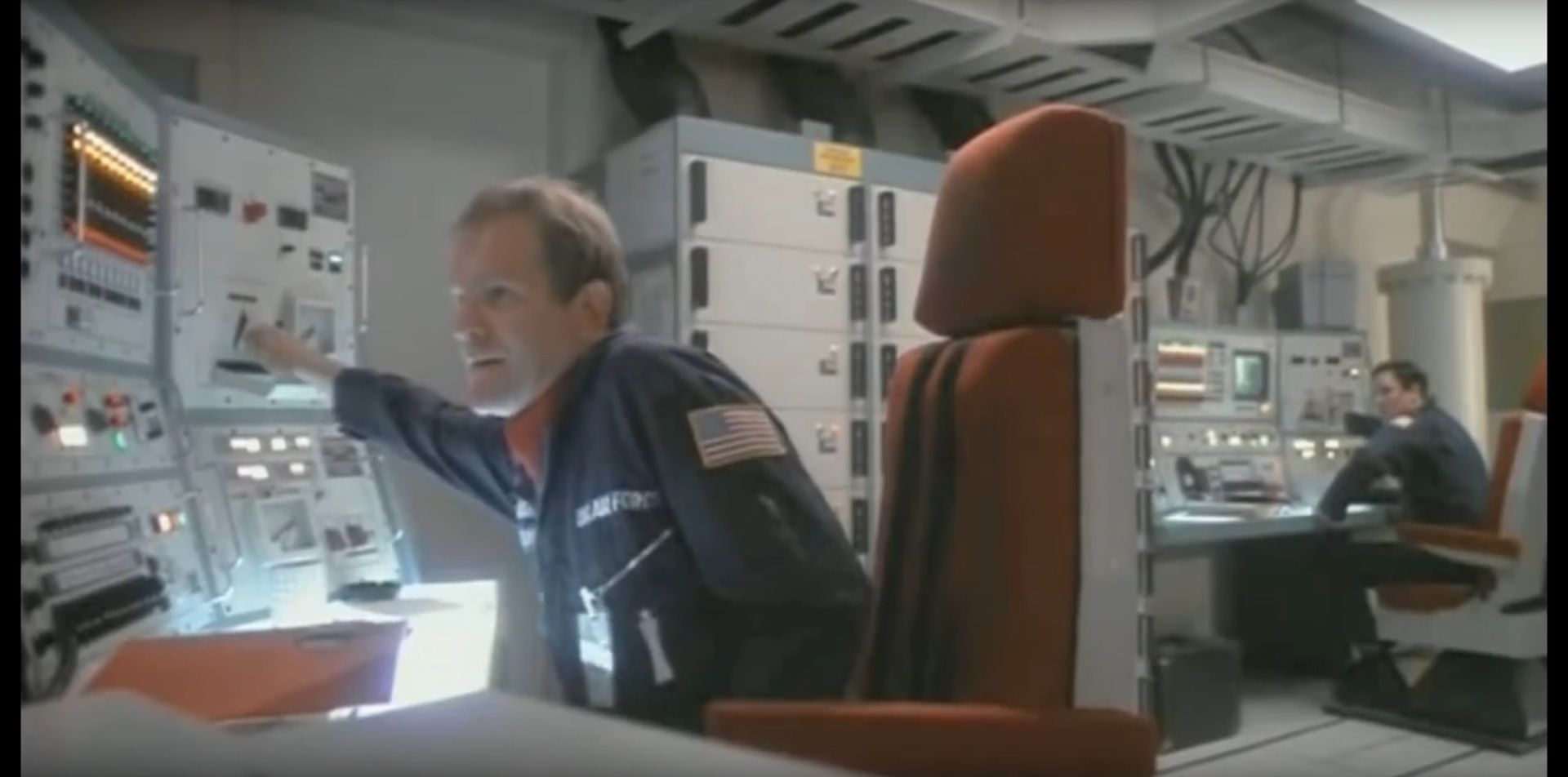
Batman in the nuclear-missile silo reminds us of a couple of things: the 1983 movie WarGames, which begins with a sequence of button-pressing and key-turning that is more nerve-wracking than you might expect; and the cover and opening pages of Watchmen #10, which turns out to be NORAD technicians tracking Air Force One and Air Force Two.
For what it's worth, the North American Aerospace Defense Command was established in 1958 as a joint effort between the United States and Canada. We suspect Gen Xers and others who grew up on WarGames have that movie's depiction of NORAD burned into their memories. In addition to tracking Santa Claus, NORAD supports the United States' Strategic Air Command (SAC), which directs land-based strategic bombers and intercontinental ballistic missiles (ICBMs). Batman probably wasn't in NORAD's main base, but odds are he was in a missile silo under SAC's control.
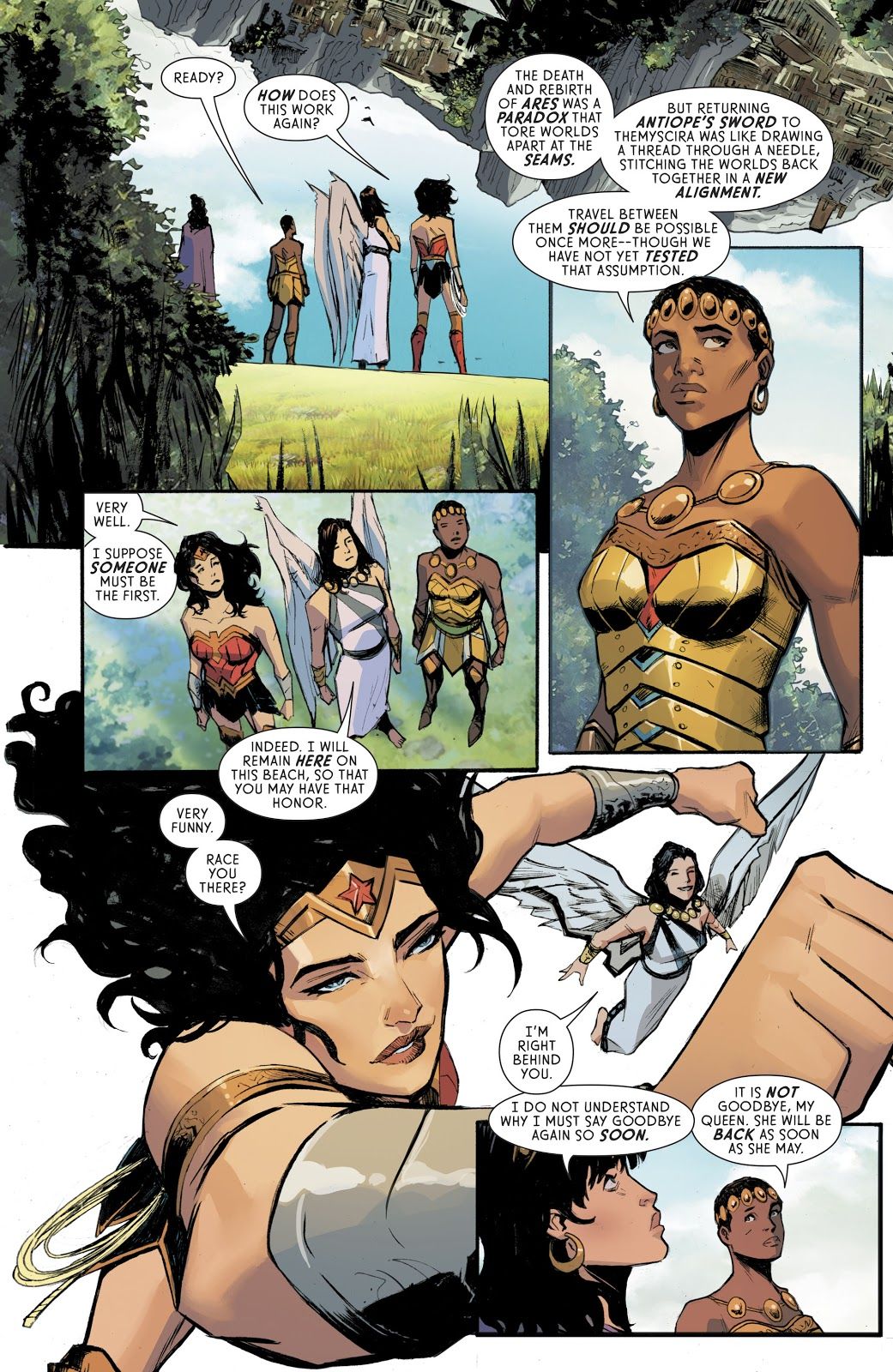
Speaking of Gotham, it looks like Doomsday Clock takes place prior to summer 2019's other big events. The "Year of the Villain" centers around a radical status-quo change for Lex Luthor, while Batman's "City of Bane" and the Superman books' Event Leviathan have pretty much sidelined Alfred Pennyworth (Pages 2, 15, 18) and Sam Lane (Page 4).
Conversely, the Amazons (Page 4) have just returned from relative limbo. Early in the New 52 era – specifically, February 2012's Wonder Woman #4 – the goddess Hera turned Hippolyta and the rest of the Amazons into stone. Much later, in January 2017's Wonder Woman issue #11, Diana realized that the New 52-style Amazons were an elaborate fiction; and in July 2017's Issue 23, she learned that the real Amazons (including Hippolyta) were still alive, but in an inaccessible dimension. Finally, in September 2019's Issue 75, the Amazons and Themyscira returned to this dimension; and in October 2019's Issue 76, Wonder Woman proved that travel between Themyscira and Patriarch's World was once again possible.
On Page 26, Ozymandias' claim that "the past won't be erased" sets up another return. The Justice Society is back in their familiar historical role as of Justice League #30. While this isn't the first time the JSA has come back after having been erased from history, it's their second-longest absence. The final Golden Age Justice Society story was in February-March 1951's All Star Comics #57, and the team returned just over 12 years later, in June 1963's The Flash #137. After that, the team was seen regularly, albeit on Earth-Two, until just after Crisis On Infinite Earths. In July 1986's Last Days of the Justice Society special, most of the JSA volunteered to stay in an endless loop of Ragnarok, in order to prevent the end of the world. They didn't come back from that until six years later, in July 1992's Armageddon: Inferno #4. Although members aged and/or died, the JSA remained part of DC's shared universe until the most recent Justice Society of America series ended in October 2011. The New 52 then featured an Earth 2 series which chronicled a more modern-day take on the JSA (but never called it that). Accordingly, it's been a little less than eight years since the classic Justice Society was removed from DC's main timeline, the longest since their Silver Age return.
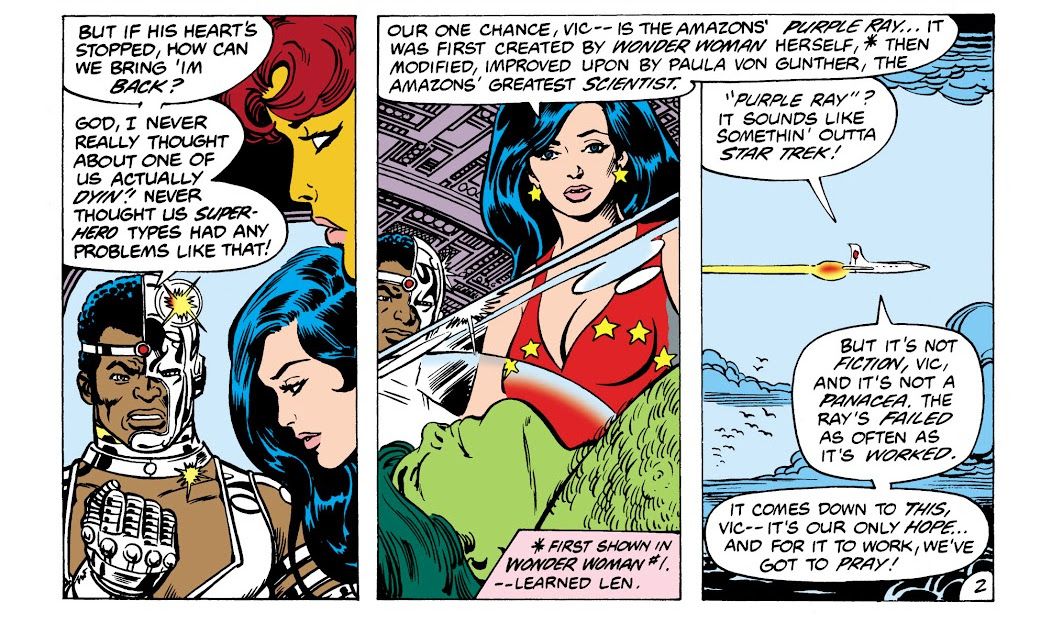
On Page 24 we learn the Amazons "abducted" Wonder Woman for her own good. Back in the day, the Amazons also came and got Wonder Woman to protect her, although the circumstances were a bit different. Then, Diana had been accused of murdering the supervillain Maxwell Lord, and the Amazons' actions sparked a brief war between Themyscira and the United States (Amazons Attack!, 2007).
The "purple light" (Page 4) refers to the Amazons' Purple Healing Ray, first seen in December 1941-January 1942's All Star Comics #8. That issue, written by William Moulton Marston and drawn by Harry Peter, also featured the first appearances of Wonder Woman and the Amazons themselves. In fact, originally Wonder Woman developed the Purple Ray to save Steve Trevor's life. Since then it's been used a number of times, including to revive the near-dead Gar "Beast Boy/Changeling" Logan in September 1981's New Teen Titans #11. Wonder Woman, Animal Man and Steel also modified the Purple Healing Ray to give everyone on Earth super-powers, so they could fight the dark god Mageddon in May 2000's JLA #41.
When Black Adam refers on Page 4 to "the descendants of those who enslaved your people," he's talking about the classic Amazon backstory first seen in All Star #8 and relatively unchanged over the decades. Essentially, the Amazons were proxies for Aphrodite in her rivalry with Ares. He didn't like how successful they were with their double-barreled message of love and martial prowess, so he got the demigod Heracles to seduce Hippolyta. The Amazons soon escaped, but Aphrodite wasn't happy that they'd gotten captured and exiled them to Themyscira.
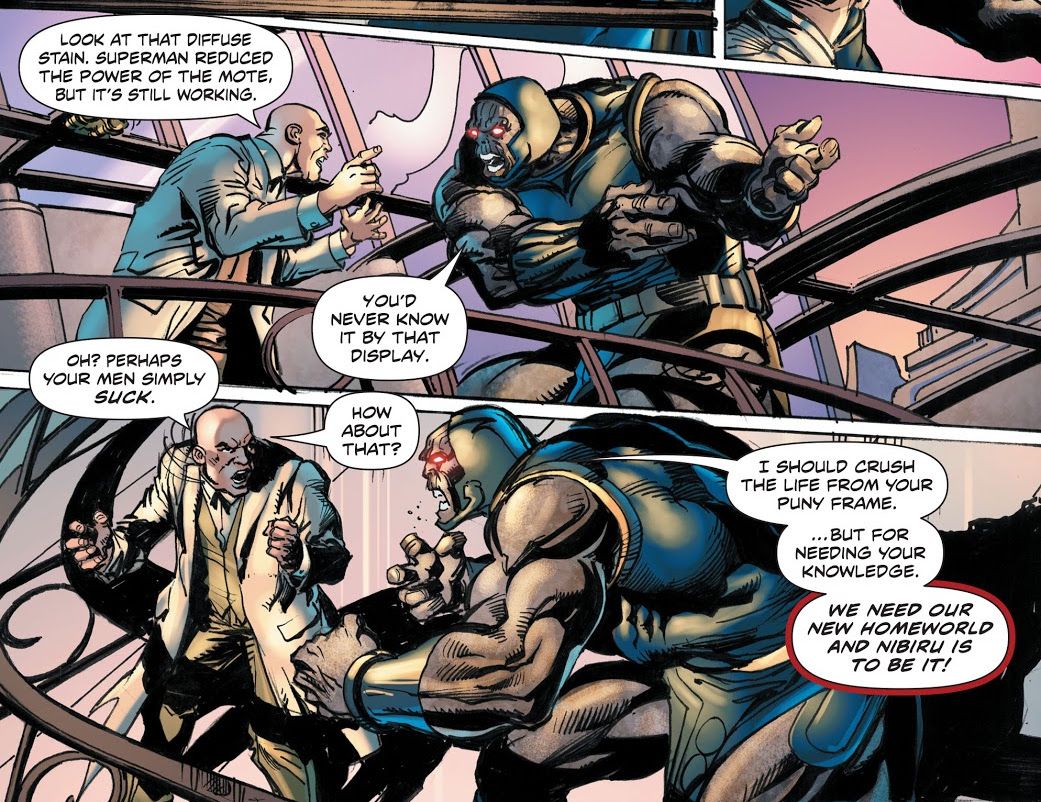
Page 5 shows a protestor's sign with a red-and-black Superman symbol. Superman's classic S-symbol has used a black background a few different times. The first was in the Max and Dave Fleischer cartoons of the early 1940s. That in turn inspired artist Alex Ross to create an even more stylized red-and-black "S" shield for the alternate future of 1996's Kingdom Come. However, we think this fits more with the red-and-black "S" Superman adopted to mourn the victims of the Imperiex War (in the Our Worlds At War crossover) as well as those of September 11, 2001's terrorist attacks. This lasted from about Superman #174 (August 2001) through Action Comics #796 (December 2002). Accordingly, the red-and-black "S" has come to mean a dark time for the Man of Tomorrow.
Luthor mentions on Page 5 that Watchmen's world isn't the first parallel Earth he's encountered. Probably the most significant was Earth-3, where everyone's just a little bad and the world's greatest super-people are the evil Crime Syndicate of Amerika. The CSA took over DC-Earth in the seven-issue Forever Evil miniseries (November 2013-July 2014; written by Geoff Johns and penciled by David Finch), and to fight them off Luthor ended up joining the good guys. What's more, Luthor and Captain Cold even joined the Justice League for a little while.
We've been wondering about the photo's inconsistencies for a while, so we're glad Luthor is here (words you never want to say) on Pages 10-12 to help clear them up.
When we think of Luthor "tracking strange anomalies" (Page 11), we think of Mark Waid and Leinil F. Yu's Superman: Birthright miniseries. There we learned that Luthor had become obsessed with the existence of alien life after intercepting a Kryptonian transmission. Naturally, Luthor used this knowledge to portray Superman as the herald of an alien invasion; but it didn't take.
Legend has it that the giant planet Nibiru (Page 11) passes by Earth every 3,600 years, and its inhabitants were humanity's first gods. Nibiru has also been co-opted into the prophecies of Nancy Lieder, who predicted in 1995 that the close passage of "Planet X" (in 2003) would disrupt Earth's rotation and magnetic field. When the 2003 event failed to happen, some claimed it was actually coming in the apocalyptic year of 2012. Nibiru's original proponent, Zecharia Sitchin, apparently never bought into either date, and predicted instead that the planet would return around 2900. For our purposes, however, the planet Nibiru featured heavily in Neal Adams' Superman: The Coming of the Supermen miniseries (April-September 2016). There, it was the home of a group of Kryptonian survivors; but Darkseid also sought to use it for his own evil ends. Originally Darkseid's ally, Luthor eventually betrayed the dark lord and helped Superman send him back to Apokolips. Thus, Luthor's reference here to "the threat of Nibiru" could refer either to Adams' miniseries or to the more conventional giant-planet story.
On Page 11, Luthor's eavesdropping on the return of Classic Wally West in 2016's DC Universe: Rebirth special.
We saw Jimmy Olsen and "Cat" Grant back in Issue 8, but the other Daily Planet staffers on Page 6 are making their D-Clock debuts. Cary Bates and Curt Swan created Steve Lombard for June 1973's Superman #264. An ex-football player, Steve imagined himself the coolest guy in the room, but his pranks on Clark Kent never seemed to work.
Brian Michael Bendis and José Luis Garcia-Lopéz created Robinson Goode (aka the Red Cloud) for a preview story in July 2018's DC Nation #0. Her first appearance after that was July 2018's Man of Steel issue #1.
While we're not quite sure who "Gil" is, we think he was mentioned in passing in one of the Christopher Reeve Superman movies.
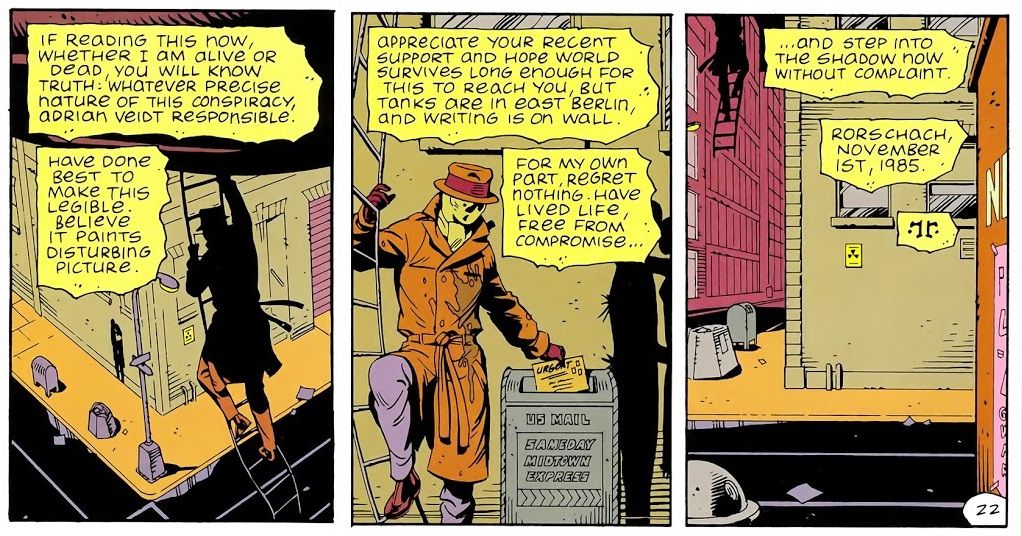
Excerpts from Rorschach's journal on Pages 1 and 2 come directly from Watchmen issue #10. They're pretty much verbatim, except for a couple of corrections ("know *the* truth" and "Veidt *is* responsible"). Of course, Panel 4 of Page 2 is a direct reference to the first panel of Watchmen issue #1.
Although Reggie's dream on Pages 16-17 isn't taken from Watchmen issue #6, it does capture Dr. Long's optimism at working with Rorschach.
Page 20 finally gives us a look at the former Nite Owl II and Silk Spectre II, now known as Sam and Sandra Hollis, last seen in the closing pages of Watchmen #12. They've adopted Mime & Marionette's first child, whom Marionette was carrying when Doctor Manhattan spared her life after foiling their bank robbery. If that happened after Dr. M and Laurie Juspeczyk moved into military housing (sometime around 1981), the child would be 3 to 4 years old by the time Watchmen ended in late 1985; and would be around 10 or 11 by 1992, when the nuclear missiles started flying.
Everyone in the big group shot on Page 22 has already appeared in Doomsday Clock. They all went to Mars in issue #9, except for Wonder Woman and Batman.
Page 23 confirms that Bubastis caused Firestorm's accident in Moscow. We knew that Bubastis had some quantum powers, but we weren't quite sure how Ozymandias had framed Firestorm.
Finally, Page 27 gives us a countdown, which is appropriate (if a little on-the-nose) for a Watchmen-related book.
Add Comments